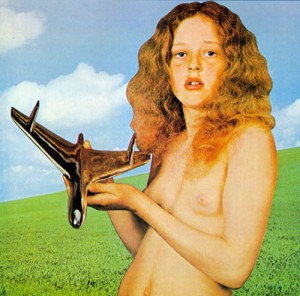 I found Bechdel’s references to “vintage” media in her work, especially newspapers and television, give Fun Home a sense of nostalgia, at least to those of us old enough to remember being kids during the 1960s. Particularly evocative is her repeated mention of the Blind Faith album (p. 95), which sets the tone for one of the scenes where Bechdel and her siblings encounter Roy, her father’s lover at the time and the baby sitter for her and her brothers.
I found Bechdel’s references to “vintage” media in her work, especially newspapers and television, give Fun Home a sense of nostalgia, at least to those of us old enough to remember being kids during the 1960s. Particularly evocative is her repeated mention of the Blind Faith album (p. 95), which sets the tone for one of the scenes where Bechdel and her siblings encounter Roy, her father’s lover at the time and the baby sitter for her and her brothers.
Released in late 1969, the sale of the album was temporarily banned in America because of the cover art; a naked pubescent girl holding a phallic symbol. Until the alternative cover was printed and issued in the U.S., the album was hard to get and finding a copy of the British release, which is the version Bruce has, was a coup of sorts. Bechdel seems to emphasize this when she refers to her father “cultivating young men” at the top of the page; it would have been a magnet to a teenage boy at the time.
Her two renderings of the album cover also presages Bechdel’s painful entry into puberty with her confusion and discomfort reflected in the banned cover art. It’s a portrait of who she had such trepidation about becoming. The young girl on the cover, rumored to be a groupie slave and/or the illegitimate child of a band member, seems at easy with her nascent sexuality while Bechdel is anything but comfortable with hers.
The lyrics reproduced in the panel sum up the scene. Bruce’s secret is catching up to him at this point and Bechdel learns later that he has had a brush with the courts. Like Wilde and Blind Faith, artists who stepped on the moral conventions of the time, Bruce is pushing his luck with his escapades. He is living outside they law, which in 1969 looked at homosexuality as being against the moral standards of the day.
The Blind Faith album, along with her references to Wilde, could be seen as Bechdel’s way of pointing out the changes time brings to society views art and the human condition. By today’s standards, the album cover would be barely rate a glance. Today Bruce wouldn’t feel compelled to hide his homosexuality behind a sham marriage that brought such grief to him and his family. Like everything else from the 60s and 70s, if his life hadn’t been such a disaster to those around him, his views of himself and his homosexuality would seem almost quaint.
Your comment about the cover art barely rating a glance reminds me of the recent news about Kanye West’s new album cover and how a lot of people are judging it as too risque (and it’s not even as risque as the Blind Faith album): http://www.rollingstone.com/music/news/51942/222703
I’m not sure Bechdel means to completely imply that her father would have been fine if he’d just been able to be openly gay or bisexual. After all, what he did was still statutory rape, which she brings up with the picture of Roy, speculating how horrifying we would find an analogous picture of a 16-year-old girl, rather like the Blind Faith cover. Which, by the way, I’m not convinced would “barely rate a glance.”
Pure random sidenote: as I commented on Kelley’s post, I actually did some construction work in Beech Creek a few years ago, and as such, was quite surprised when I started to read “Fun Home” and I recognized all the architecture, etc. Anyway, while I was there, I rescued a bunch of records from the trash of the home we were working on. Among them–the Blind Faith album (albeit it the “censored” cover).
Oh and I’m with Ian–that original cover is still awkward! (ha).
Tim, this is a great piece of archeological work—a close reading of a tiny sliver of one panel that you extract much historical and thematic meaning from.
Tim, I agree with your comparison between the social acceptance of the girl on the cover and Bechdel’s unease with her fit in society. Background on the album helped authenticate and place Fun House in time.